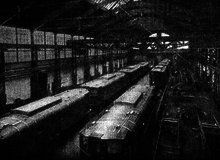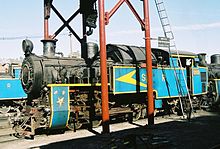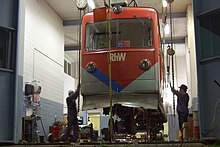Swiss locomotive and machine factory

The Swiss Locomotive and Machine Works ( SLM ) was a Swiss company in the heavy industry is based in Winterthur . Founded in 1871 as a steam locomotive factory, parts of the company were sold, made independent or closed from 1998. Last active from 2001 under the name Winpro , the last business unit was taken over by Stadler Rail in 2005 .
history
The "Schweizerische Maschinen- und Lokomotivfabrik" (SLM) was founded in Winterthur in 1871 by Charles Brown after Sulzer had disagreements with the then patron, Heinrich Sulzer-Steiner . In the immediate vicinity of Sulzer, the administration building and the first factory buildings were built on a plot of land on the Tössfeld by 1873, later “Plant 1”, with a direct track connection to the growing Swiss railway network.
The first locomotive left the 1873 built no. 7 of the Vitznau-Rigi Railway 's work. The boiler of No. 7 was installed upright so that the heating pipes were completely surrounded by water even when they were tilted, in order to reduce the risk of a boiler explosion . The no. 7 was scrapped 1937th It is now on display in the Swiss Museum of Transport (VHS) in Lucerne and is occasionally put back into circulation on anniversaries.
First financial successes came with Zahnradlokomotiven , while abroad, especially locomotives for intercity tram (so-called secondary tracks ) were in demand. Economic downturns as well as the bankruptcy of the Swiss National Railway led to an unsteady course of business, whereupon the production of steam engines and boilers began in 1882. The diversification was extended to gas engines and gas generators in 1884.
A dividend could be distributed for the first time in 1883, this rose to 10% by 1889 and remained at this level until 1909; The SLM had become the largest Swiss locomotive manufacturer and invested in the expansion. From 1896 to 1898 further parcels were bought south of Jägerstrasse. From 1900 onwards, "Plant 2" was built on these, and the new factory buildings included workshops, magazines and warehouses, and a new foundry. The administration building was enlarged between 1905 and 1906. In 1907, a building plot west of Zürcherstrasse was purchased as a land reserve, on which “Plant 3” was finally built in 1931.
With various manufacturers such as Brown, Boveri & Cie. (BBC), the Maschinenfabrik Oerlikon (MFO) and the Société Anonyme des Ateliers de Sécheron (SAAS), a collaboration was established for the construction of the electric locomotives that were widespread in Switzerland early on , with SLM supplying the chassis and superstructures. Thanks to the collaboration between BBC and Metropolitan Vickers from England , SLM also received well-known export orders to the British colonies such as India and South Africa , where SLM was able to supply the mechanical part for 78 SAR class E1 locomotives from 1923 , which was the largest at the time Order for electric locomotives of a single series was. The SLM HG 4/4 delivered hot steam locomotives for mixed adhesion and gear operation to the French colony of Indochina at the time. In Switzerland she went through the Mitfabrikation successful SBB - locomotives as Ae 3/6 I and Ae 4/7 a name.
After the Second World War, the large-scale production of steam locomotives was phased out, making the casting and forging of steam boilers less and less popular. Sulzer seized the opportunity and took over the majority of SLM in 1961. In the course of the following restructuring, all duplications were eliminated, the departments of engine construction (gas, diesel), compressors / pumps, apparatus construction, as well as forge and gray cast iron production were absorbed by Sulzer or discontinued (e.g. farm tractors ). The workforce of 2265 was reduced by transferring to Sulzer; In 1970, the 100th business year of SLM, the company still employed 1270 people. Sales also increased in the same period; from 1963 a dividend of 9% was distributed. Sulzer also succeeded in using plant 2 of SLM to capacity with its own orders, which as a competitor they shied away from.
After the Second World War, the SLM shaped the Swiss rail network with its bogie locomotives without running axles; the lineage BLS Ae 4/4 (1944), Re 4/4 I (1946), Ae 6/6 (1952), BLS Re 4/4 (1964), Re 4/4 II (1964), and Re 6 / 6 (1972) was built until the 1980s and came to around 575 units, for SBB and BLS alone. The SLM played its well-established role as the developer of the entire vehicle mechanics: the locomotive frame, box, casing, roof and the bogies. For vehicle electrics, the Swiss consortium partners MFO, BBC and SAAS were used, which increasingly contributed to joint developments; with the takeover of MFO in 1967 and SAAS in 1969 by the BBC, the latter became the most important co-developer.
In the 1980s, the SLM suffered from a slump in domestic orders, as smaller railways relied heavily on railcars that the SLM did not offer due to a standstill agreement with SWS / SWP , FFA and SIG . The 1982 Re 4/4 IV prototype locomotives developed with BBC were not a resounding success either; In 1981, the SBB relied on a 7th construction lot of the proven Re 4/4 II , which were delivered by 1985.
An important export success was achieved with the 50 Hz working group (50 c / s Group) in the form of the CNR series 8K , a further development of the SNCF BB 15000 in cooperation with Alsthom-MTE . For 48 of the 50 double locomotives (96 units), the mechanical part was delivered to China from 1985 to 1987 under the leadership of MTE. A final collaboration with the 50 Hz group in 1990 led to the construction of three copies of the Spoornet class 14E for South Africa, the 14E1 replica of which was later built under an SLM license.
In Switzerland, the KTU locomotives developed again with BBC from 1987, the first Swiss converter locomotives in GTO technology, found buyers at private railways and paved the way for the Re 450 (1989) for the S-Bahn, ordered in four lots by the SBB Zurich (115 pieces). Swiss meter-gauge railways rely on both the HGe 4/4 II (with gear drive) and the newly designed Ge 4/4 (III) (without gear drive).
The last joint development with ABB, as the BBC called itself from 1990, were the two “Lok 2000” series Re 460 (1992) and Re 465 (1994). With the latter, SLM / ABB also won tenders from Finland ( Sr2 ), Norway ( El 18 ) and Hong Kong ( KCRC TLN / TLS ). With the transfer of TLS (serial number 5744) to Adtranz in Oerlikon - for final assembly and commissioning of the traction train - production was stopped in 1997 and SLM was effectively dissolved in its 127th business year by its parent company Sulzer.
Dissolution and whereabouts
In 1998, SLM was renamed Sulzer-Winpro AG and the workforce, except for a staff of 350, was laid off. Furthermore, the cog railways product area was sold to Stadler Rail , and engineering was sold to Bombardier Transportation via Adtranz .
As early as mid-2000, the steam locomotive technology was outsourced from SLM and made independent as the steam locomotive and machine factory DLM .
The measurement technology department (established as a physical laboratory at SLM ) was taken over by PROSE AG in October 2001 .
After a management buy-out in 2001, Winpro AG was founded, which was involved in the automotive, rail vehicle, systems and mechanical engineering sectors. On September 7, 2005, Winpro was completely taken over by Stadler Rail and renamed Stadler Winterthur AG in 2006.
Historical archive of the SLM
In cooperation with Sulzer and Bombardier Transportation and the Transportation Museum Switzerland took over Heritage Foundation SBB ( "SBB Historic") the plan Archive of SLM in early 2004. On 300 m² stood in the former administrative building at Zürcherstrasse 41 in Winterthur more than 100,000 plans , the SLM's photo collection, factory brochures, order documents and other archive material are available.
Managed as a branch of SBB Historic, the decision was made in 2017 to move the archive to Windisch, the foundation's headquarters, by the end of 2018 and to integrate it into the archive there. The archive has been accessible to the public there again since April 2019.
Production of road vehicles
The company manufactured a lightweight automobile in 1899 . The vehicle offered space for four people. A single-cylinder engine with 7 HP (5 kW) power provided the drive . It is not known whether the vehicle remained a one-off or was produced in small quantities. In 1906 trucks with steam engines followed . Around 15 commercial vehicles with gasoline engines were built between 1924 and 1932 .
In 1934 the next attempt to get into automobile production followed. The brand name was SLM-Pescara . According to plans by Raúl Pateras Pescara , the earlier the Fábrica Nacional de Automóviles SA had directed, created sixteen-cylinder engines . The V-shaped engines produced 150 hp (110 kW) from a displacement of 3600 cm³ with the help of a compressor . Chausson made the chassis . The handmade cabriolet body from a French body manufacturer offered space for two people. Overall, only one vehicle was completed, which Pescara took over. In addition, two more engines were created. Both the vehicle and the two engines no longer exist today.
See also
- Section locomotives in the article rack railway
- Winterthur system
- Winterthur control
literature
- Abendrot Foundation / Project Management Lagerplatz (ed.): Lagerplatz Winterthur. A changing industrial quarter. editions denkstatt, Basel 2015, ISBN 978-3-9524556-1-6 .
- Furthermore railway technology from Winterthur . In: Eisenbahn-Revue International , issue 10/2003, ISSN 1421-2811 , p. 444 f.
- George Nick Georgano : The Beaulieu Encyclopedia of the Automobile, Volume 3 P – Z. Fitzroy Dearborn Publishers, Chicago 2001, ISBN 1-57958-293-1 (English) (for the production of road vehicles)
Web links
- Hans-Peter Bärtschi: Swiss locomotive and machine factory. In: Historical Lexicon of Switzerland .
- SLM archive from SBB Historic
- winterthur-glossar.ch: Swiss locomotive and machine factory
- Stadler Winterthur AG formerly Winpro AG
- DLM AG
- PROSE AG former "physical laboratory of the SLM"
Individual evidence
- ↑ Rigi Bahnen say goodbye to steam locomotive No. 7 - goodbye! Bahnonline.ch, December 8, 2009, accessed on October 18, 2018 .
- ^ Natal Contract to British . In: Electric Railway Journal . 61, January 13, 1923, p. 107. Retrieved September 15, 2010.
- ↑ Walter Frech, Michael Nold: The HG 4/4 704, an attractive addition to the locomotive on the Furka mountain route . In: Swiss Railway Review . No. June 6 , 2019.
- ↑ SLM archive at SBB Historic. Retrieved September 14, 2015
- ↑ SBBH blog: SLM move , accessed on December 25, 2018
- ↑ Claudia Meier: A real treasure trove for model builders. Aargauer Zeitung, April 5, 2019, accessed on August 24, 2019 .



